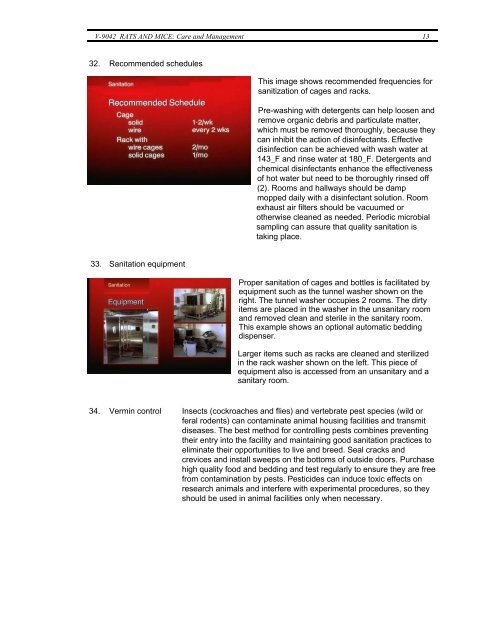LABORATORY ANIMAL MEDICINE AND SCIENCE - SERIES II ...
LABORATORY ANIMAL MEDICINE AND SCIENCE - SERIES II ...
LABORATORY ANIMAL MEDICINE AND SCIENCE - SERIES II ...
You also want an ePaper? Increase the reach of your titles
YUMPU automatically turns print PDFs into web optimized ePapers that Google loves.
V-9042 RATS <strong>AND</strong> MICE: Care and Management 1332. Recommended schedulesThis image shows recommended frequencies forsanitization of cages and racks.Pre-washing with detergents can help loosen andremove organic debris and particulate matter,which must be removed thoroughly, because theycan inhibit the action of disinfectants. Effectivedisinfection can be achieved with wash water at143_F and rinse water at 180_F. Detergents andchemical disinfectants enhance the effectivenessof hot water but need to be thoroughly rinsed off(2). Rooms and hallways should be dampmopped daily with a disinfectant solution. Roomexhaust air filters should be vacuumed orotherwise cleaned as needed. Periodic microbialsampling can assure that quality sanitation istaking place.33. Sanitation equipmentProper sanitation of cages and bottles is facilitated byequipment such as the tunnel washer shown on theright. The tunnel washer occupies 2 rooms. The dirtyitems are placed in the washer in the unsanitary roomand removed clean and sterile in the sanitary room.This example shows an optional automatic beddingdispenser.Larger items such as racks are cleaned and sterilizedin the rack washer shown on the left. This piece ofequipment also is accessed from an unsanitary and asanitary room.34. Vermin control Insects (cockroaches and flies) and vertebrate pest species (wild orferal rodents) can contaminate animal housing facilities and transmitdiseases. The best method for controlling pests combines preventingtheir entry into the facility and maintaining good sanitation practices toeliminate their opportunities to live and breed. Seal cracks andcrevices and install sweeps on the bottoms of outside doors. Purchasehigh quality food and bedding and test regularly to ensure they are freefrom contamination by pests. Pesticides can induce toxic effects onresearch animals and interfere with experimental procedures, so theyshould be used in animal facilities only when necessary.


